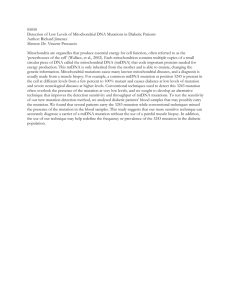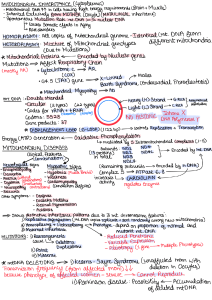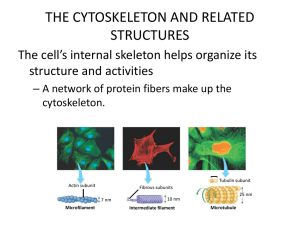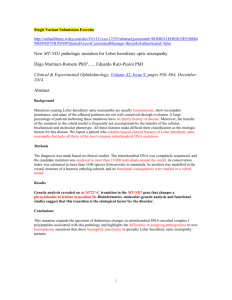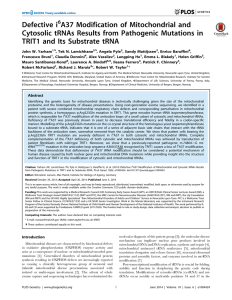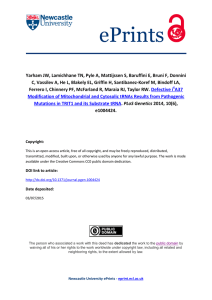of Mitochondrial Single Nucleotide Polymorphisms MELAS, MERRF, NARP
advertisement
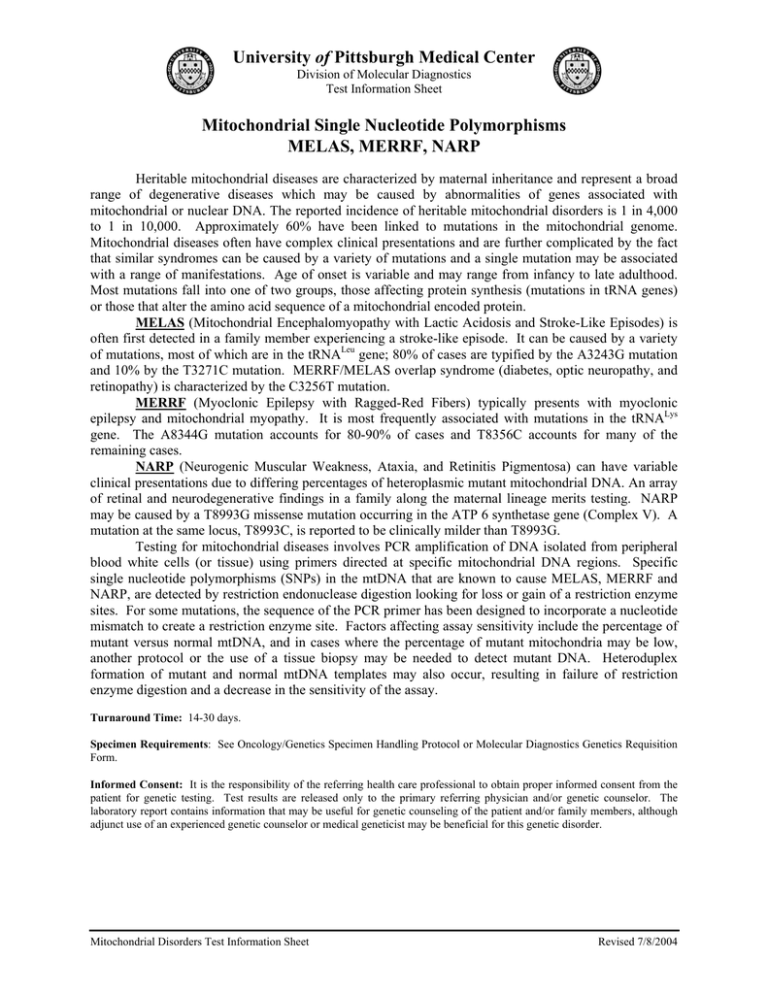
University of Pittsburgh Medical Center Division of Molecular Diagnostics Test Information Sheet Mitochondrial Single Nucleotide Polymorphisms MELAS, MERRF, NARP Heritable mitochondrial diseases are characterized by maternal inheritance and represent a broad range of degenerative diseases which may be caused by abnormalities of genes associated with mitochondrial or nuclear DNA. The reported incidence of heritable mitochondrial disorders is 1 in 4,000 to 1 in 10,000. Approximately 60% have been linked to mutations in the mitochondrial genome. Mitochondrial diseases often have complex clinical presentations and are further complicated by the fact that similar syndromes can be caused by a variety of mutations and a single mutation may be associated with a range of manifestations. Age of onset is variable and may range from infancy to late adulthood. Most mutations fall into one of two groups, those affecting protein synthesis (mutations in tRNA genes) or those that alter the amino acid sequence of a mitochondrial encoded protein. MELAS (Mitochondrial Encephalomyopathy with Lactic Acidosis and Stroke-Like Episodes) is often first detected in a family member experiencing a stroke-like episode. It can be caused by a variety of mutations, most of which are in the tRNALeu gene; 80% of cases are typified by the A3243G mutation and 10% by the T3271C mutation. MERRF/MELAS overlap syndrome (diabetes, optic neuropathy, and retinopathy) is characterized by the C3256T mutation. MERRF (Myoclonic Epilepsy with Ragged-Red Fibers) typically presents with myoclonic epilepsy and mitochondrial myopathy. It is most frequently associated with mutations in the tRNALys gene. The A8344G mutation accounts for 80-90% of cases and T8356C accounts for many of the remaining cases. NARP (Neurogenic Muscular Weakness, Ataxia, and Retinitis Pigmentosa) can have variable clinical presentations due to differing percentages of heteroplasmic mutant mitochondrial DNA. An array of retinal and neurodegenerative findings in a family along the maternal lineage merits testing. NARP may be caused by a T8993G missense mutation occurring in the ATP 6 synthetase gene (Complex V). A mutation at the same locus, T8993C, is reported to be clinically milder than T8993G. Testing for mitochondrial diseases involves PCR amplification of DNA isolated from peripheral blood white cells (or tissue) using primers directed at specific mitochondrial DNA regions. Specific single nucleotide polymorphisms (SNPs) in the mtDNA that are known to cause MELAS, MERRF and NARP, are detected by restriction endonuclease digestion looking for loss or gain of a restriction enzyme sites. For some mutations, the sequence of the PCR primer has been designed to incorporate a nucleotide mismatch to create a restriction enzyme site. Factors affecting assay sensitivity include the percentage of mutant versus normal mtDNA, and in cases where the percentage of mutant mitochondria may be low, another protocol or the use of a tissue biopsy may be needed to detect mutant DNA. Heteroduplex formation of mutant and normal mtDNA templates may also occur, resulting in failure of restriction enzyme digestion and a decrease in the sensitivity of the assay. Turnaround Time: 14-30 days. Specimen Requirements: See Oncology/Genetics Specimen Handling Protocol or Molecular Diagnostics Genetics Requisition Form. Informed Consent: It is the responsibility of the referring health care professional to obtain proper informed consent from the patient for genetic testing. Test results are released only to the primary referring physician and/or genetic counselor. The laboratory report contains information that may be useful for genetic counseling of the patient and/or family members, although adjunct use of an experienced genetic counselor or medical geneticist may be beneficial for this genetic disorder. Mitochondrial Disorders Test Information Sheet Revised 7/8/2004



